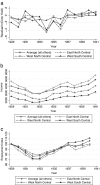Evidence on early-life income and late-life health from America's Dust Bowl era
- PMID: 17686988
- PMCID: PMC1948901
- DOI: 10.1073/pnas.0700035104
Evidence on early-life income and late-life health from America's Dust Bowl era
Abstract
In recent decades, elderly Americans have enjoyed enormous gains in longevity and reductions in disability. The causes of this progress remain unclear, however. This paper investigates the role of fetal programming, exploring how economic progress early in the 20th century might be related to declining disability today. Specifically, we match sudden unexpected economic changes experienced in utero in America's Dust Bowl during the Great Depression to unusually detailed individual-level information about old-age disability and chronic disease. We are unable to detect any meaningful relationship between early life factors and outcomes in later life. We conclude that, if such a relationship exists in the United States, it is most likely not a quantitatively important explanation for declining disability today.
Conflict of interest statement
The authors declare no conflict of interest.
Figures

Similar articles
-
Dust to Feed, Dust to Gray: The Effect of in Utero Exposure to the Dust Bowl on Old-Age Longevity.Demography. 2024 Feb 1;61(1):87-113. doi: 10.1215/00703370-11140760. Demography. 2024. PMID: 38214503
-
Why is the teen birth rate in the United States so high and why does it matter?J Econ Perspect. 2012 Spring;26(2):141-66. doi: 10.1257/jep.26.2.141. J Econ Perspect. 2012. PMID: 22792555
-
Multigenerational Effects of Early-Life Health Shocks.Demography. 2019 Oct;56(5):1855-1874. doi: 10.1007/s13524-019-00804-3. Demography. 2019. PMID: 31359286
-
Population health in an era of rising income inequality: USA, 1980-2015.Lancet. 2017 Apr 8;389(10077):1475-1490. doi: 10.1016/S0140-6736(17)30571-8. Lancet. 2017. PMID: 28402829 Review.
-
Migration in later life: evidence from the British Household Panel Study.Popul Trends. 2010 Autumn;(141):74-91. doi: 10.1057/pt.2010.22. Popul Trends. 2010. PMID: 20927030 Review.
Cited by
-
Variation in the effects of family background and birth region on adult obesity: results of a prospective cohort study of a Great Depression-era American cohort.BMC Public Health. 2015 Jun 5;15:535. doi: 10.1186/s12889-015-1870-7. BMC Public Health. 2015. PMID: 26088317 Free PMC article.
-
Assessing health outcomes in the aftermath of the great recession: a comparison of Spain and the Netherlands.Int J Equity Health. 2020 Jun 5;19(1):84. doi: 10.1186/s12939-020-01203-6. Int J Equity Health. 2020. PMID: 32503561 Free PMC article.
-
Is the Social Safety Net a Long-Term Investment? Large-Scale Evidence From the Food Stamps Program.Rev Econ Stud. 2024 May;91(3):1291-1330. doi: 10.1093/restud/rdad063. Epub 2023 Jun 8. Rev Econ Stud. 2024. PMID: 39281422 Free PMC article.
-
Health and the Economy in the United States, from 1750 to the Present.J Econ Lit. 2015 Sep;53(3):503-570. doi: 10.1257/jel.53.3.503. J Econ Lit. 2015. PMID: 26401057 Free PMC article.
-
Barker's Hypothesis Among the Global Poor: Positive Long-Term Cardiovascular Effects of in Utero Famine Exposure.Demography. 2023 Dec 1;60(6):1747-1766. doi: 10.1215/00703370-11052790. Demography. 2023. PMID: 37937904 Free PMC article.
References
-
- National Center for Health Statistics. Health United States. Hyattsville, MD: National Center for Health Statistics; 2006.
-
- Freedman V, Martin L, Schoeni R. J Am Med Assoc. 2002;288:3137–3146. - PubMed
-
- Lakdawalla D, Bhattacharya J, Goldman D. Health Affairs. 2004;23:168–176. - PubMed
-
- Cutler D, Liebman J, Smyth S. How Fast Should the Social Security Eligibility Age Rise? Cambridge, MA: Harvard University; 2006.
Publication types
MeSH terms
Grants and funding
LinkOut - more resources
Full Text Sources

